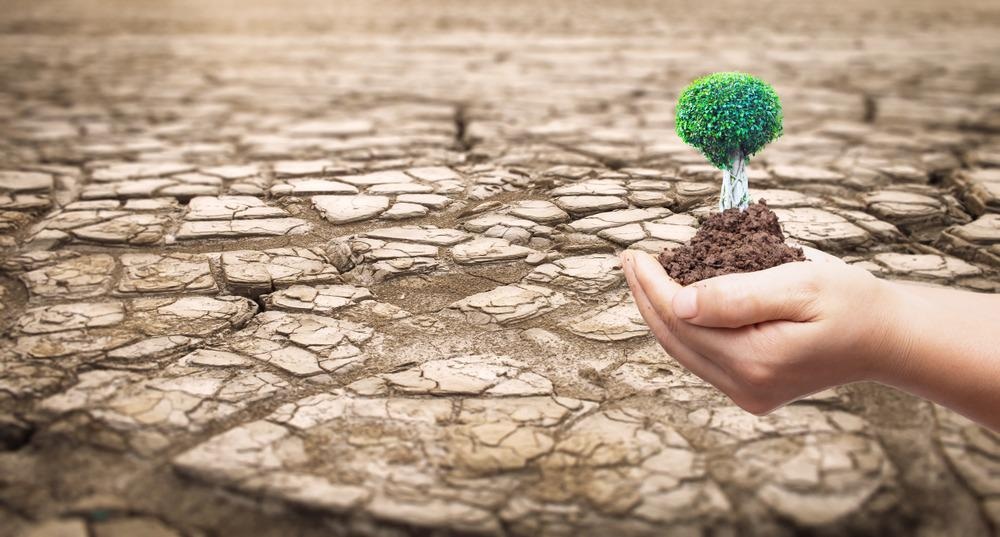
Image Credit: Paul shuang/Shutterstock.com
A low-tech, widely applicable nanotechnology solution has been developed with the potential to reverse desertification. Norwegian cleantech company Desert Control has been developing its highly effective nanoclay solution for decades. Now it can be produced commercially and at scale, potentially revolutionizing agriculture around the world.
What is Desertification?
Desertification is the degradation of drylands that become increasingly arid over time because of human activity or other environmental factors. It can be a result of overexploitation, where nutrients have been taken from the soil too quickly without allowing soil time to recover. Deforestation and prolonged periods of drought are also possible causes of desertification.
Whatever the cause, the result is the same: desert land that cannot be farmed.
Around 40% of the earth’s land area is classified as “dryland”. Of this 40%, an estimated 10-20% has degraded due to desertification. This represents between 6 and 12 million square kilometers – that is, a total area around the size of Europe and Australia combined.
The problem is growing as dryland soil conditions continue to deteriorate. Researchers now place up to one billion people at risk of further desertification in the coming years.
Nanoclay to Combat Desertification
Nanoclay was developed to tackle this global challenge. Low-tech clay has been used for millennia to improve soil conditions. Mixing it with dry soils can help them to retain more water, enabling crops planted in them to access more nutrients for healthy growth.
However, mixing heavy clay with soil is incredibly labor-intensive, hard work. Furthermore, the process exposes valuable carbon sequestered in the topsoil to the elements, causing it to be released into the atmosphere. It further harms soil systems by breaking up the fungal networks that keep plants in communion with one another and with the wider ecosystem underground.
The nanoclay solution developed by Desert Control retains the soil-improving qualities of clay applications without the harmful and labor-intensive task of mixing clay into the soil.
Nanoclay is sprayed onto the surface in a water-based solution before regular water irrigation. Nano-sized particles of a clay mixture specially selected for the local soil and conditions slip below the surface and through particles of soil to the optimum depth (10-20 cm).
Nanoclay binds to the dry soil it touches due to the negative charge carried by clay molecules and positive charge in the sandy soil molecules. This results in a clay layer around each particle of soil of around 200-300 nm in a snowflake-like formation. This increased surface area traps water in the soil and allows water and nutrients to chemically combine with the sandy soil before they run off from it.
One treatment of nanoclay can last up to five years. It can improve water retention by up to 65% and reduce the need for water irrigation by up to 47%. The treatment can also be simply performed with virtually no training or professional expertise required and using common agricultural tools.
Video Credit: Mountain Dew/YouTube.com
The Development of Nanoclay
Nanoclay has been in development for decades, with Norwegian cleantech company Desert Control leading the charge in terms of innovation, research, and development for this ground-breaking technology.
As well as being the first to investigate nanoclay solutions to soil degradation, Desert Control has also been a forerunner in developing the solution to ensure its effectiveness and success.
The company has engaged in more than a decade of trials in China, Egypt, the United Arab Emirates (UAE), and Pakistan. The result of this extensive testing has been the precise refinement of different recipes for nanoclay that will work optimally in local conditions.
Different soils worldwide have different chemistries and ecosystems, and so there is no one size fits all nanoclay solution that can be universally applied.
Taking Nanoclay Worldwide
Following this extensive period of testing and development, Desert Control has now embarked on the path towards commercially scaled manufacturing with independent testing and approval from the International Center for Biosaline Agriculture (ICBA) in Dubai in 2020.
As part of its plans to deliver the nanoclay solution to every corner of the globe, Desert Control has also developed a low-cost, portable manufacturing facility that fits inside a shipping container. The intention is to send hundreds of these facilities around the world to produce nanoclay that is optimized for local conditions and can be transported to nearby sites with minimal environmental and economic transport costs incurred.
Desert Control is currently able to set up a nanoclay treatment operation for approximately $2.00 per square meter of land. At this price, it is a viable solution for affluent suburban communities in the UAE, where it is being used to restore parks.
However, Desert Control is actively seeking ways to bring this upfront cost down as much as possible. This will be achieved largely through economies of scale as production expands, with the company targeting a $0.20 per square meter price point.
Desert Control is also working with the United Nations Convention to Combat Desertification on the ambitious Great Green Wall Project, which is building a wall of trees and agroforestry to halt desert expansion in North Africa.
References and Further Reading
Lovell, Rachel (2021) The Spray That Turns Deserts Into Farmland. BBC. [Online] Available at: https://www.bbc.com/future/bespoke/follow-the-food/the-spray-that-turns-deserts-into-farmland.html
United Nations Convention to Combat Desertification (2021) The UN Decade for Deserts and the fight against Desertification: Impact and role of drylands. UNCCD. [Online] Available at: https://www.unccd.int/
Disclaimer: The views expressed here are those of the author expressed in their private capacity and do not necessarily represent the views of AZoM.com Limited T/A AZoNetwork the owner and operator of this website. This disclaimer forms part of the Terms and conditions of use of this website.